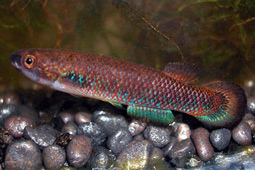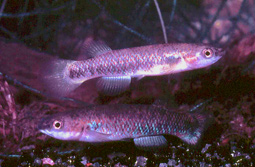History
No alternative name for this species.
In fact Roloff discovered the species in 1937 and wrote an aquariumarticle in 1938 in which he mentionned the name Rivulus roloffi and the author Trewavas, as was the species described already by Trewavas who was working on it. This discription from Trewavas however was not published yet and became delayed by the Second World War. Than she published it in 1948. Despite the article from Roloff did not showed a diagnose, and by that did not meet the standards of the international Nomenclatur Comission's rules, Roloff was seen as first describer than and by that discribed a fish named after himself. Lazara (1984) changed the authorship to "Rivulus roloffi, Trewavas in Roloff" but this was overruled with arguments by Dr. Jean Huber (2006). He than designated Trewavas as single author of this species.
Reproduction
Keeping and breeding is easy but a good cover of the aquarium is necessary because there ability to jump, even true the smallest opening, is unbelievable.
This species can, if there is enough space for them, housed in a tank with more males than one only and several females. If separated before and brought together again however, they can be very agressive to each other and fight to become dominant to others. The best way to have much offspring is to put a pair or an trio in a small tank from 10 liters with a small filter in it or with some airation. On the bottom some peat moss or dark gravel and a floating "mop" to give space for laying there eggs. The fish will, if they become a rich varity of life food, spawn during there whole adult life and produce daily between 5 to 10 eggs.
The eggs should be collected by hand and stored for about 20 days in a small container. Eggs are 1.8 mm and amber colored. It is wise, to add to the water you store the eggs in, some acryflavine to provent fungus coming up.
After hatching the young fry can eat fresh artemia nauplii without any problem. It takes 4 to 5 months to raise them to maturity. Often the number of males is far above the number of females. For some species this can become a major problem for the breeder as he has to raise many young fishes and so become able to distribute a few pairs to other hobbyists. Recent personal tests laerned that lower pH levels during the time of hatching gave a higher percentage of females. To achieve this I use some peat moss that I add to the container with the egss just before they are ready to hatch. This peat moss also is a good way to prevent eggs to become attact by fungusses.
There lifespan can be up to 3,5 years in captivity.
Remarks :
Rivulus roloffi could become (according to logical aspects ) member of the Kryptolebias Genus after deepened study of the skeleton and mitochondrial DNA.
Variations
Map
Meristics
Max. size 4.0 cm.
Dorsal 11.0,
Anal 16.0,
D/A 7.0,
LL scale count (average)34.0
Pre- dorsal length to % SL – 72.0 %
Depth to % SL – 20.1 %
Literature

